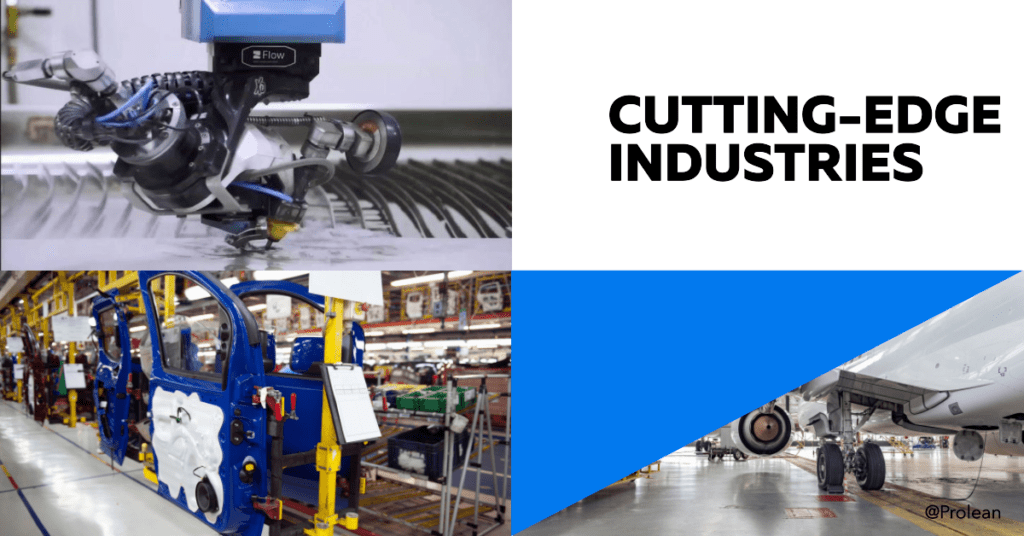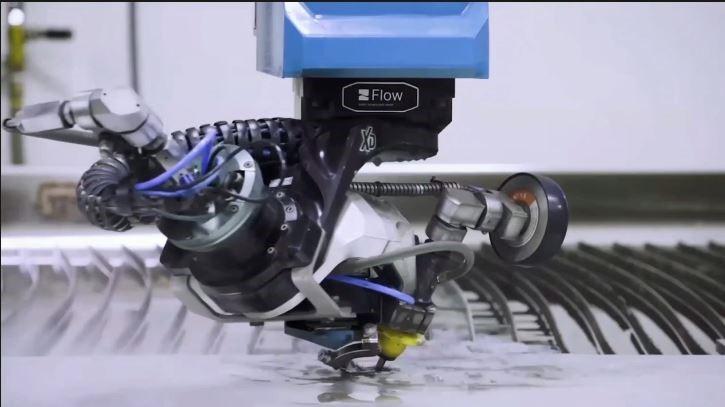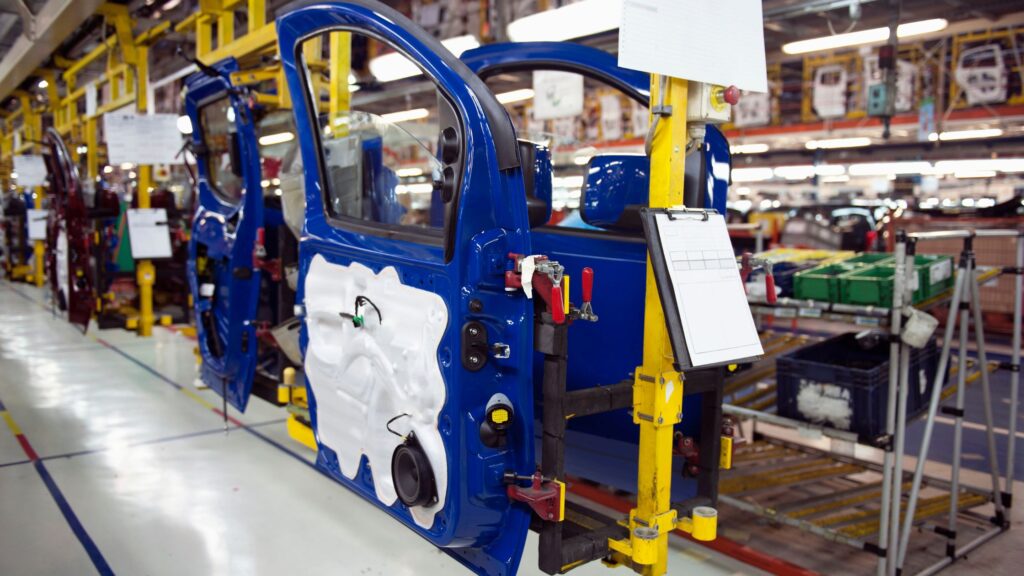
Water jet cutting stands out for its versatility and efficiency in cutting methods. Its ability to accurately cut through various materials, from soft rubber to hardened steel, has proven to be a game-changer in several industries. Moreover, waterjet cutting is prized for its precision and minimal waste generation, making it an eco-friendly option in manufacturing. These characteristics have resulted in its broad adoption across several sectors.
This article will delve into five industries that have particularly benefited from waterjet cutting technology, utilizing its unique advantages to create many components and products.
Aerospace Industry

In an industry where precision is paramount, aerospace has become a significant advocate for waterjet cutting technology. With a wide array of components to fabricate and a constant push for innovation, the aerospace industry requires a cutting method to keep up with its demands. Waterjet cutting has more than risen to the occasion.
Fabricating Aerospace Components

The aerospace industry heavily relies on waterjet cutting to create a variety of critical components. These include turbine blades, interior parts, and structural elements, each requiring the highest levels of precision and quality. For instance, the accuracy afforded by waterjet cutting is crucial when constructing turbine blades, where even the slightest deviation can lead to inefficiency or, worse, failure.
Furthermore, waterjet cutting offers versatility in handling various materials, from composite materials to metals like titanium. This versatility is crucial in the aerospace industry, where components often comprise different materials to achieve the desired performance and weight balance.
Table 1: Waterjet Cutting Applications in the Aerospace Industry
| Aerospace Component | Benefits of Waterjet Cutting |
|---|---|
| Turbine Blades | Exceptional precision, compatibility with various materials |
| Structural Parts | Reduced waste, precise cuts, suitable for numerous materials |
| Interior Components | Highly accurate, can handle complex designs and diverse materials |
Rapid Prototyping
The aerospace industry is often at the forefront of technological innovation, requiring rapid prototyping capabilities to test new designs and concepts. Waterjet cutting is an invaluable tool, enabling manufacturers to quickly and accurately produce prototype parts for evaluation and testing. The process minimizes the time between design conception and prototype creation, facilitating faster innovation cycles and more efficient product development.
Read more: Water Jet Cutting in Aerospace Applications
Automotive Industry

The automotive industry is another significant user of waterjet cutting, utilizing the technology for various manufacturing processes. This sector has high demands for speed, efficiency, and precision, making waterjet cutting an ideal choice.
Manufacturing Automotive Parts
Waterjet cutting is crucial for automotive parts, from engine components to decorative trims. For example, engine parts like pistons, connecting rods, or crankshafts made from durable metals are often shaped using waterjet cutting because they can handle thick, robust materials with high precision.
Moreover, automotive aesthetics are increasingly important in the modern market, and waterjet cutting is used to create decorative elements with intricate designs. The method is particularly effective for cutting materials like plastics and glass, commonly used for interior and exterior trims.
Table 2: Waterjet Cutting Applications in the Automotive Industry
| Automotive Application | Benefits of Waterjet Cutting |
|---|---|
| Engine Components | High precision, ability to cut through thick and durable materials |
| Decorative Trim | Highly accurate cuts, reduced material waste, suitable for diverse materials |
Rapid Prototyping and Customization
Like the aerospace industry, the automotive sector relies heavily on rapid prototyping. The capability to quickly produce physical parts from digital designs greatly accelerates product development. It also aids in customization, a growing trend in the automotive market where customers seek unique designs or modifications. With waterjet cutting, manufacturers can create custom parts quickly and accurately, meeting the rising demand for personalized vehicles.
Related Resource: Which cutting method is better – plasma or laser? Ultimate Guide 2022
Try Prolean Now!
Electronics Industry
The electronics industry is a vast, ever-evolving field that thrives on innovation and precision. When it comes to the production of electronic components, waterjet cutting stands as a crucial player.
Production of Circuit Boards and Components
Waterjet cutting is frequently utilized in producing printed circuit boards (PCBs), where intricate patterns are required to be accurately cut from insulating materials. The waterjet cutting process’s high precision and non-thermal nature are ideal for creating these components without causing damage or deformation.
Various other electronic components like connectors, insulators, and heat sinks are also produced using waterjet cutting. The process is beneficial for cutting ceramic materials, commonly used in electronics for their insulating properties.
Table 3: Waterjet Cutting Applications in the Electronics Industry
| Electronics Application | Benefits of Waterjet Cutting |
|---|---|
| Printed Circuit Boards (PCBs) | High precision, non-thermal process, reduced material waste |
| Connectors and Insulators | Can handle delicate and intricate designs appropriate for diverse materials |
| Heat Sinks | Precise cuts, suitable for various materials, including ceramics |
Prototyping and Custom Electronics
The electronics industry is another sector where rapid prototyping is critical, particularly in the smart devices and IoT era. Waterjet cutting allows manufacturers to convert designs into physical components for testing and evaluation.
Furthermore, the demand for custom electronics has been growing, and waterjet cutting offers the flexibility to cater to these demands. It allows for quick and accurate production of unique electronic components that meet individual requirements.
Medical Industry
Given the critical nature of its devices, the medical industry has unique needs for precision and reliability. Waterjet cutting has found extensive applications in this sector, especially in producing medical devices and implants.
Production of Medical Devices and Implants
Waterjet cutting is extensively used to create intricate and precise medical device components, such as surgical instruments and diagnostic equipment. The ability to cut a wide range of materials, including stainless steel, titanium, and various plastics, makes it an ideal method in this diverse industry.
Moreover, implants such as artificial joints or dental prosthetics require high precision and biocompatibility. Waterjet cutting can precisely shape these implants from suitable materials, ensuring a high level of quality and safety.
Table 4: Waterjet Cutting Applications in the Medical Industry
| Medical Application | Benefits of Waterjet Cutting |
|---|---|
| Surgical Instruments | High precision, can handle a variety of materials |
| Diagnostic Equipment | Accurate cuts, appropriate for diverse materials |
| Implants | Precise shaping, suitable for biocompatible materials |
Construction Industry
The need for cutting large and durable materials is shared in the construction industry. Waterjet cutting, with its ability to handle a broad range of materials and thicknesses, is a precious tool in this field.
Cutting Building Materials
Waterjet technology can cut building materials like stone, concrete, metal, and glass. Whether creating intricate designs in stone for decorative elements or cutting large steel beams, waterjet cutting provides the precision and versatility needed.
Table 5: Waterjet Cutting Applications in the Construction Industry
| Construction Application | Benefits of Waterjet Cutting |
|---|---|
| Decorative Elements | Can handle intricate designs, suitable for diverse materials |
| Structural Elements | Can cut through thick and robust materials, high precision |
Maritime Industry
Waterjet cutting is not just confined to land-based industries; it plays a significant role in the maritime industry as well.
Shipbuilding and Repair
Waterjet cutting is instrumental in shipbuilding, where large steel plates and other robust materials need to be cut and shaped precisely. The process is quick, accurate, and minimizes waste, making it an efficient choice for such a large-scale industry.
The maritime industry also uses waterjet cutting for ship repair and maintenance. Here, the method’s capability to cut without generating heat prevents structural damage to the ship, which can be critical in repair operations.
Table 6: Waterjet Cutting Applications in the Maritime Industry
| Maritime Application | Benefits of Waterjet Cutting |
|---|---|
| Shipbuilding | Precise and efficient cutting of large steel plates |
| Ship Repair | Non-thermal process prevents damage during repair |
Equipment Manufacturing
Many pieces of equipment used in the maritime industry, such as engine parts, safety equipment, and navigational components, are manufactured using waterjet cutting. The process’s versatility and precision make it suitable for producing these diverse components.
Summing Up
Waterjet cutting is a versatile and efficient method used in various industries. Its ability to cut a wide range of materials precisely without generating heat has made it a popular choice in sectors ranging from aerospace and automotive to electronics, medical, construction, and maritime. As manufacturing processes become more advanced and demanding, waterjet cutting will likely find even more applications, making it an invaluable tool for the industry.
Waterjet cutting is a versatile and efficient method used in various industries. Its ability to cut a wide range of materials precisely without generating heat has made it a popular choice in sectors ranging from aerospace and automotive to electronics, medical, construction, and maritime. As manufacturing processes become more advanced and demanding, the application of water jet machining will likely become more common, making it an invaluable tool for the industry.
Prolean’s waterjet cutting service offers precision, efficiency, and versatility. We cater to all the industries mentioned above and more, providing high-quality waterjet cutting that meets diverse and demanding requirements. With our state-of-the-art equipment and experienced technicians, we guarantee superior results for all your waterjet cutting needs.
FAQs
Can waterjet cutting be used on all materials?
Waterjet cutting can be used on a wide range of materials, including metal, stone, glass, and plastics. However, it may not be suitable for certain brittle materials or those that can be damaged by water.
How precise is waterjet cutting?
Waterjet cutting is a highly precise method that can produce intricate designs with tight tolerances. The exact precision can depend on factors like the material and the specific equipment used.
Does waterjet cutting generate heat?
No, waterjet cutting is a cold-cutting process that does not generate significant heat. This prevents heat-related damage or deformation to the material.
Can waterjet cutting be used for large-scale applications like shipbuilding?
Yes, waterjet cutting is well-suited for large-scale applications. It can efficiently cut large and robust materials, making it a popular choice in industries like shipbuilding.
Can waterjet cutting be used for delicate applications like electronics or medical devices?
Yes, the high precision of waterjet cutting makes it suitable for delicate applications. It can produce intricate designs and shapes, making it useful for industries like electronics and medical devices.




0 Comments